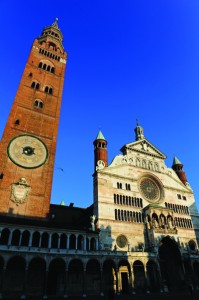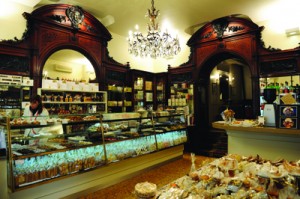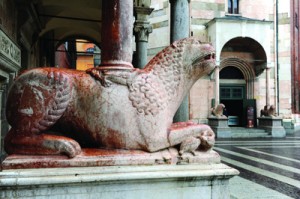A lesser-known gem of northern Italy, often shrouded in mist, Marina Spironetti shows us what Cremona has to offer ? a city known as the capital of the violin industry…
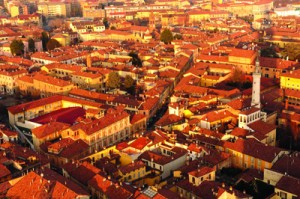 The diligent lady at the tourist information office has equipped me with everything I could possibly need for my short stay in Cremona: maps, leaflets and all kinds of books. ?If you are stout-hearted, you can ascend the Torrazzo,? she suggests.
The diligent lady at the tourist information office has equipped me with everything I could possibly need for my short stay in Cremona: maps, leaflets and all kinds of books. ?If you are stout-hearted, you can ascend the Torrazzo,? she suggests.
?It?s 502 steps but the view is breathtaking.? When I asked how to get there, she smiled condescendingly: ?It?s just opposite, see?? and then she pointed her finger towards a precise point in the dense fog that enveloped the square.
That?s what happens when you live in Cremona: you develop the ability to see things through the thick mist that swallows them for most of the time, especially in winter. Milan is little more than an hour away and I can?t believe I left a spotless blue sky there. The problem with Cremona is that not only is it right in the middle of that imposing flatland that is the pianura padana, but it is also too close to the Po, Italy?s longest river. You never know when the fog will disappear ? sometimes it goes around midday, sometimes it persists for longer. You develop a sort of philosophical attitude towards it.
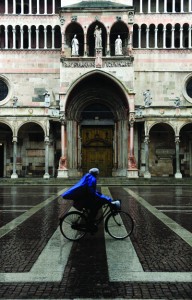 It?s even colder in the fog ? and damper. Still, there is something romantic about it, something in the way it slowly reveals the elegant curves and scrolls on the brick and terracotta palazzi of the city. On a day like this, the marble of the Romanesque Duomo seems even whiter. It acquires a dreamlike nature. Mist or not, I am standing in the city?s loveliest square. The medieval centre of religious and social life, with the marble of the cathedral and the baptistery on one side and the red bricks of the Palazzo del Comune (now the town hall) and the arcades of the Loggia dei Militi on the other.
It?s even colder in the fog ? and damper. Still, there is something romantic about it, something in the way it slowly reveals the elegant curves and scrolls on the brick and terracotta palazzi of the city. On a day like this, the marble of the Romanesque Duomo seems even whiter. It acquires a dreamlike nature. Mist or not, I am standing in the city?s loveliest square. The medieval centre of religious and social life, with the marble of the cathedral and the baptistery on one side and the red bricks of the Palazzo del Comune (now the town hall) and the arcades of the Loggia dei Militi on the other.
Taking a closer look, there is also an outdoor pulpit; a relic of those charismatic, itinerant preachers, whose sermons were so popular they had to be held outside. As the fog starts to vanish, I am finally able to look all the way up to the top of the 112m-high Torrazzo, one of the symbols of the city. Only slightly shorter than the cathedral in Milan, it features battlements as well as bells and it even tells the hour thanks to a fine astronomical clock. Aside from the time, its complex mechanism, which is still working today, shows the lunar phases, lunar and solar eclipses and the zodiac.
That long-gone world, with all its beliefs, is there in a nutshell.
Walking down the streets of the centre, you might hear violin music coming from a window. You might run into a passing musician with a cello case over the shoulder. You might peep through the windows of the workshops and catch a glimpse of the liutai, the violin makers, at work, hunched over their wares. After all, Cremona has been the capital of the violin industry since the mid 16th century.
The city was home to three of the most famous names in stringed instrument-making history: Amati, Guarnieri and Stradivari. The old workshops of the three great men were razed to the ground by the fascists, and a boxy, Mussolini-era Galleria stands there instead. The small, undistinguished statue of Antonio Stradivari ? in a piazza behind the Civic Museum ? is easy
to miss, and so is his grave, in the main park, transferred there from a demolished church.
But the city does not rest on its cultural laurels ? it keeps working. Over 60 violin makers keep up the tradition. Many of them are graduates from Cremona?s prestigious international violin making school. There is also a Consortium of Violin Makers, where they give you a map of the workshops in the city. While there, I stumble across Daniele Ciaccio, who agrees to show me his shop nearby (via F. Cavallotti 13, +39 0372 24711 www.violinscremona.it).
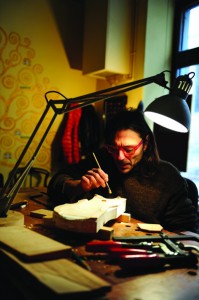 On his table is an old German instrument, which he is patiently restoring when not making new ones. He enthusiastically talks about the different phases of violin making, answering all my novice questions. Daniele has got that special passion that is required for a job like this. It takes a couple of months from start to finish ? in this microcosm where the production line is anathema, haste obviously makes waste.
On his table is an old German instrument, which he is patiently restoring when not making new ones. He enthusiastically talks about the different phases of violin making, answering all my novice questions. Daniele has got that special passion that is required for a job like this. It takes a couple of months from start to finish ? in this microcosm where the production line is anathema, haste obviously makes waste.
?There is something quite spiritual about what I do,? he says. ?I don?t really know how it happens, but it feels like all my feelings can be transferred from my hands into the instrument; be it joy or sadness, the process seems to soak it all up.?
Working at another table is Luca, a younger chap whom I initially mistake for Daniele?s assistant. He seems to be keener on talking about the music he writes than in the secrets of woodcarving. According to Daniele, he is a much more talented composer than a violin maker. It is quite ironic, then, to consider that he is the last descendant of Antonio Stradivari.
?Nobody in the family is a violin maker,? Luca says ?but we all play an instrument at least.? He plays the violin, the piano and the viola. And that?s what he is doing at Daniele?s: making his own viola. It might take him a bit longer and he might never become a craftsman like his ancestor, but listening to his music I would say he certainly has a bright future as a composer.
Violin making must be a very strenuous business, as the city is blessed with more caf?s and restaurants than you could possibly wish for ? as well as a lively nightlife. The city?s culinary specialities seem to have something of the sweetness of the violin in them ? from the renowned torrone (nougat) to the Mostarda di Cremona ? candied cherries, melons and apricots in a sweet or piquant mustard sauce, served with boiled meats. Cremonese food is rich and imaginative, from cured and seasoned pork to cheeses.
Among the latter, try the salva cremasco, a dense seasoned cheese with a very white colour, which comes in a tall square shape with a dark rind. Its very aromatic taste can be fully appreciated with tighe ? cornet-shaped green peppers ?scalded? in vinegar and immersed in oil. If pasta is your thing, you will be spoilt for choice. Look out for marubini di Cremona, with a meat filling, cooked in broth made with pork, beef and chicken.
There is nothing better than a walk to burn off all the calories of the Cremonese cuisine. Wandering away from the centre rewards me with a series of unexpected sights, such as the minaret along via del Cistello, the lovely church of Sant?Abbondio, in a little-known, very atmospheric square, or the 11th-century church of Sant?Agata, where Stradivari got married to his first wife. Those who are feeling more energetic also have the option of a bike tour, which will enable you to discover the peaceful countryside around the city. Cremona has recently launched inBici, a bike rental scheme, which at the moment is still is free of charge (check www.comune.cremona.it for further information).
Once you are in the saddle, take either via Po or via del Sale ? either of them will take you to the river in no time. If you stay on the left bank, you will come across a small port and the Parco al Po, an area equipped with sport facilities such as swimming pools, bike tracks, soccer fields and a skating ring.
Looking beyond the fields, you will be rewarded with the most stunning view of the city, its red rooftops in the distance, the top of its ornate church fa?ades, its mighty towers talking of long-gone times. And the mist will only add more charm to it.
GETTING THERE
By plane: Parma airport is about 50km away. Flights from the UK depart with Ryanair from Stansted ? see www.ryanair.com. Alternatively, you can fly to Milan from several airports and Cremona is about an hour?s drive (100km) from there.
By train: There are regular trains from both Milan and Parma. Trains are direct from Milan central and take 70 minutes (around ?6 one way). From Parma, you can change at either Piacenza or Fidenza. Trains take 50 minutes (?4 standard one way).
By car: From Milan, take the A1 motorway south. Exit at Piacenza and take the A21 to Cremona. From Parma take the A1 motorway north and exit at Fiorenzuola for the A21 to Cremona.
Within the city: Most of the notable sights are within easy walking distance, but there is also a regular bus service around the city.

